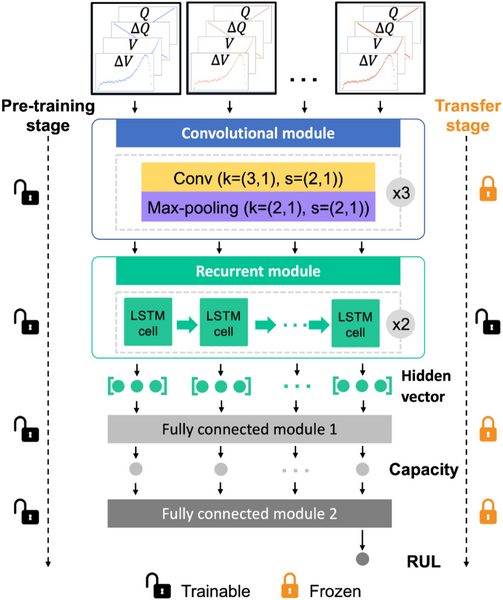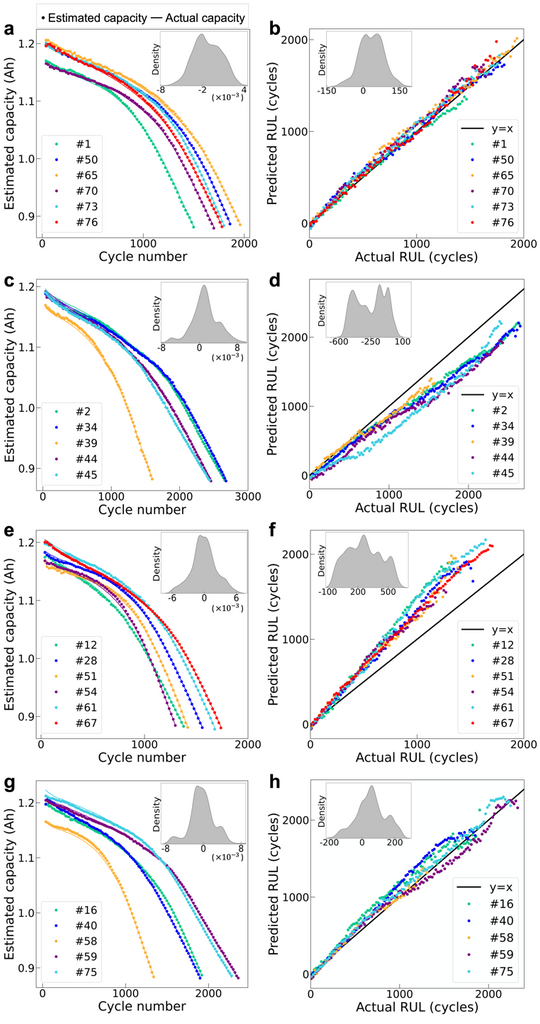Customized lithium battery health management solutions for users are crucial to improving the safety of lithium batteries. Limited by different usage habits, dynamic operating modes and limited historical data, real-time personalized lithium battery health prediction faces great challenges. This study discloses a comprehensive dataset of 77 LFP/graphite lithium batteries (77 discharge schemes) with over 140,000 charge-discharge cycles, and develops a deep transfer learning framework that utilizes the most recent 30 current cycles. Cyclic local charge and discharge data enables real-time personalized health state prediction for any cycle of the new battery discharge strategy. The average test errors of the proposed framework are 0.176% and 8.72% for capacity estimation and remaining life prediction, respectively. Furthermore, the proposed algorithmic framework enables migration between different charging configurations, ambient temperatures, and battery materials. The study leveraged two public datasets to facilitate capacity estimation (0.328%/0.193%) and remaining life prediction (9.80%/9.90%).

In the context of the "dual carbon" goal, the electrification of power systems has become an inevitable trend in the development of power electronics. As the "heart" of electronic devices, the health of lithium batteries is of great importance. In recent years, the optimization of charging strategies for lithium batteries has attracted a lot of research. In contrast, due to the differences in usage preferences among different lithium battery users, the discharge management of lithium batteries is also an extremely important link. Real-time personalized prediction of lithium battery health status (i.e. capacity and remaining service life) under different discharge strategies will provide users with safe and planable usage scenarios and strengthen lithium battery health management. In addition, lithium battery health management technology can promote the advancement of self-healing and recycling technology, and has the potential to assist the development of a new generation of batteries. For example, the user can estimate the current state of health of the lithium battery after high-power discharge, and formulate a new usage plan to extend the remaining life of the lithium battery based on the current estimation results. Likewise, manufacturers can test the current performance of lithium batteries after extreme discharge, which can be used to improve battery designs. Additionally, recyclers are able to assess the current state of health of lithium batteries to determine if they are suitable for reuse (and if so, for which applications), remanufacturing or recycling. Therefore, real-time personalized battery health management technology can serve different objects such as users, manufacturers and recyclers.
The real-time personalized health prediction of lithium batteries faces two main problems: the difference of discharge strategies and the real-time prediction. First, due to the large differences in the usage habits of different users, as well as different battery chemistries, ambient temperatures, and historical data, the same discharge strategies and lithium battery degradation patterns rarely exist. Therefore, if the health status of the new battery is directly predicted through the historical data of other batteries, there may be a large deviation. Previous work has focused on lifetime prediction by extracting common high-performance features from previous battery cycling data, or personalized modeling and prediction using at least 25% degradation data per cell. On the one hand, the use of common features produces predictable prediction errors due to ignoring the individualized degradation patterns of each cell. On the other hand, the prediction accuracy of previous work prediction methods is highly dependent on the amount of data. Second, real-time is an important goal of health state prediction, users can grasp the current battery health state in real time and schedule maintenance or replacement accordingly, while existing research focuses on predicting the battery health state given several cycles.
Currently, transfer learning can utilize other different but related domain knowledge to transfer to the target domain to help the target domain achieve better learning results. As an important branch of transfer learning, deep transfer learning does not require manual feature engineering. At present, deep transfer learning methods have been successfully applied to various applications, such as medical diagnosis, chemistry, natural language processing, and intelligent manufacturing. For different lithium battery usage patterns, deep transfer learning has great potential to help realize real-time personalized lithium battery health prediction.
In view of this, Academician Ding Han, Professor Yuan Ye, and Professor Huang Yunhui of Huazhong University of Science and Technology proposed a set of transferable deep learning framework to realize real-time personalized lithium battery health prediction. Using the local charge-discharge data of the last 30 cycles of the current cycle, the proposed transfer learning framework can quickly predict the health of lithium batteries for this cycle. The algorithm framework proposed in this study is verified on the supporting LFP/graphite lithium battery data set, and the average errors of capacity estimation and remaining life prediction are 0.176% and 8.72%, respectively. The algorithm framework can also realize the migration prediction between lithium batteries with different materials, different ambient temperatures, and different charge-discharge configurations, and the effectiveness of the proposed scheme is further verified by using two public datasets. The algorithm framework can be extended to other discharge scenarios (such as constant current discharge, random discharge, etc.), as well as fast charging scenarios (such as multi-step charging, pulse charging, constant power charging, etc.). In addition, the proposed algorithm framework is expected to be extended to quasi-solid-state batteries, solid-state batteries, and post-lithium-ion batteries (such as lithium-sulfur batteries, sodium-ion batteries, etc.).



